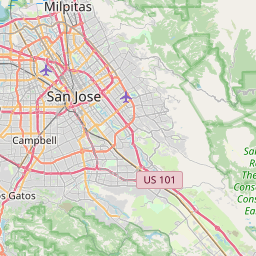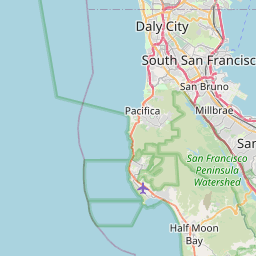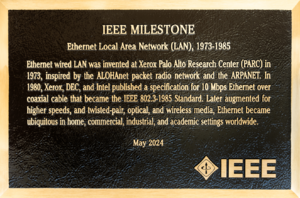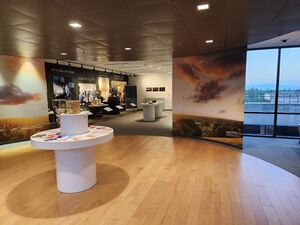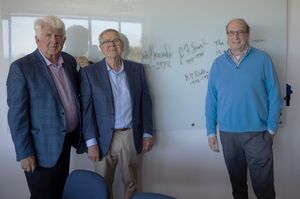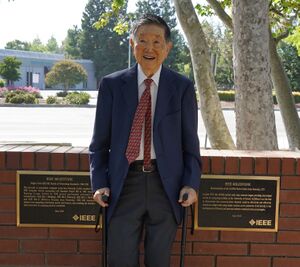Milestones:Ethernet Local Area Network (LAN), 1973-1985
- Date Dedicated
- 2024/05/17
- Dedication #
- 253
- Location
- Palo Alto, CA
- IEEE Regions
- 6
- IEEE sections
- Santa Clara Valley
- Achievement date range
- 1973-1985

Title
Ethernet Local Area Network (LAN), 1973-1985
Citation
Ethernet wired LAN was invented at Xerox Palo Alto Research Center (PARC) in 1973, inspired by the ALOHAnet packet radio network and the ARPANET. In 1980, Xerox, DEC, and Intel published a specification for 10 Mbps Ethernet over coaxial cable that became the IEEE 802.3-1985 Standard. Later augmented for higher speeds, and twisted-pair, optical, and wireless media, Ethernet became ubiquitous in home, commercial, industrial, and academic settings worldwide.
Note: "IEEE 802.3-1985 Standard" in the above citation is officially known as "ANSI/IEEE Std 802.3-1985."
Street address(es) and GPS coordinates of the Milestone Plaque Sites
- Site 1: PARC (part of SRI International), 3333 Coyote Hill Road, Palo Alto, CA 94304 US (37.402370, -122.148354)
- Site 2: Computer History Museum, 1401 N. Shoreline Blvd, Mountain View, CA 94043 US (37.414757, -122.077679)
Details of the physical location of the plaque
- Site 1: On the back wall of The Innovation Museum, which is to the left of the front reception desk, and alongside 2 other IEEE Milestone plaques (Xerox Alto and Laser Printer)
- Site 2: On the inside face of the front patio brick wall, near the museum's Main Entrance
How the plaque site is protected/secured
- Site 1: Building security; 8am-4:30pm access on weekdays
- Site 2: Building security; 24/7 access
Historical significance of the work
Until around 1970, the mass market need for data communication was primarily long reach, i.e., not just within a building. There were several efforts to develop wide area networks (WANs) to connect large computers to each other over a distance, including the ARPANET and the UK's NPL Mark I network.
During the late 1960s and 1970s, the availability of increasingly complex and inexpensive integrated circuits led to the proliferation of affordable minicomputers and personal smaller computers intended for operation by individual users. This created a need for a Local Area Network (LAN) to enable communication between these computers in a building or site-wide campus, and at higher speeds than could be achieved with modems over voice-grade circuits.
In particular, the Xerox Palo Alto Research Center (PARC), founded in 1970, needed a high-speed interconnect for its newly-developed Alto personal computers to enable sharing of data, and access to centralized resources of laser printers, file servers, and an ARPANET gateway. By 1981, Xerox had installed 75 Ethernets at 40 sites in the USA and UK, serving over 1350 Altos, the sites interconnected via gateways and T1 and voice-grade circuits. [Ref10: Hitzik] By 1985, an estimated 500,000 Ethernet adapters had been installed worldwide, corresponding to about 100,000 Ethernets. [Ref11: Pelkey, p. 486] Within two decades, Ethernet became the dominant worldwide standard for wired local communication for computers and computing devices. [Ref9: Burg]
Obstacles (technical, political, geographic) that needed to be overcome
The Alto personal computer at Xerox PARC was a new approach to a user's workplace. Each machine had a display screen, keyboard, and mouse, and was dedicated for use by a single user. For this new workplace, PARC's employees needed a low-overhead, high-speed decentralized local communication scheme to tie together their Alto computers and the PARC laser printers, file servers, and gateway to the ARPANET.
The solution was inspired by the University of Hawaii’s ALOHA System project, and in particular its innovative design for a random-access packet broadcast channel. [Ref8: ALOHAnet, 1971 IEEE Milestone]. In 1973, Xerox PARC’s networking expert, Robert Metcalfe, who had previously worked on the ARPANET at MIT’s Project MAC, proposed a wired network to capture the ALOHAnet’s wireless “ether” into a coaxial cable with no centralized control. [Ref1: Metcalfe's 1973 Ethernet Memo] In addition, Metcalfe added a carrier sense capability, where a node would only attempt to transmit when the cable was quiescent. Metcalfe also invented a “binary exponential backoff” algorithm to improve on the ALOHAnet random retransmission algorithm in order to reduce the chance of an unstable or locked-up network under excessive loading conditions. [Ref3: US Patent No. 4,063,220], [Ref4: Comm ACM 1976] In 1973, Bob Metcalfe and Dave Boggs prototyped their Experimental Ethernet using Manchester-encoded baseband transmission at 2.94 MHz (half the Alto’s clock rate) on a shared, single-conductor, serial coaxial cable accessed via cable-puncturing taps. [Ref2: How Ethernet Was Invented], [Ref10: Hitzik]
Several obstacles to acceptance within Xerox PARC and the nascent local networking community included overcoming concerns that the network offered “only probabilistic” packet delivery, and that it exhibited indeterministic packet delivery latency under load (due to the randomized backoff retransmission algorithm). Alternative network designs based on a circulating “token" were a prominent competitive approach. In spite of the concerns and initial implementation bugs, by 1975 there were 25 nodes on PARC's Experimental Ethernet, interconnecting Altos, Data General Nova minicomputers, printers, a mainframe (MAXC), and the ARPANET, thereby demonstrating the viability of the Ethernet approach to the computing community as well as the industry. [Ref10: Hitzik], [Ref9: Burg]
Starting in 1977, Xerox began working with other companies to create an updated version of Ethernet for broad industry use. The 10 Mb/s Ethernet 1.0 "Blue Book" specification was jointly published in September 1980 by the “DIX” consortium that consisted of Digital Equipment Corporation (DEC), Intel, and Xerox. [Ref5: DIX Ethernet V1.0 1980]
The Ethernet 1.0 Blue Book specification was submitted to the newly organized IEEE 802 LAN/MAN Standards Committee as a proposal for the IEEE LAN standard. However, because there were other contenders for such a standard, the IEEE 802 Committee eventually published three standards that were incompatible for low-level LAN access: Token Bus (802.4), Token Ring (802.5), and Ethernet (802.3). The Ethernet standard, also known as CSMA/CD (“carrier-sense multiple access with collision detection”), was essentially taken from the Ethernet 1.0 Blue Book.
The 802.3 standard was approved by the IEEE on June 24, 1983, and published on December 31, 1984 as ANSI/IEEE Std 802.3-1985 IEEE Standards for Local Area Networks: Carrier Sense Multiple Access with Collision Detection (CSMA/CD) Access Method and Physical Layer Specifications. [Ref6: IEEE 802.3-1985 Spec]
In 1990, the 802.3 IEEE standard and all of its amendments were adopted and issued by JTC1 as ISO/IEC 8802-3 1990(E). (JTC1 is a joint technical committee of the International Organization for Standardization and the International Electrotechnical Commission, and its purpose is to develop, maintain, and promote standards for information and communications technology.) Since JTC1 has adopted all amendments and all revisions to the 802.3 standard since 1990, this has led to the IEEE standard becoming ubiquitous with its worldwide adoption.
Features that set this work apart from similar achievements
Since its approval in 1983 and publication in 1985, IEEE Standard Ethernet has expanded features, media, and speeds to adapt to the broad market needs for locally-wired computer communications. Always at the forefront was both simplicity and interoperability: each step forward in the evolution of the Ethernet standard was formulated to be backward compatible with previous versions at the client interface. The use of thin coaxial media (10BASE2) lowered installation costs. Twisted-pair media (10BASE-T), in conjunction with the multi-port repeater, allowed installations to use existing surplus telephone cabling, which had often become the property of building owners after AT&T's deregulation in 1982. This reduced installation costs even more significantly, and improved both reliability and maintainability.
IEEE 802.4 never really gained volume market traction because of high cost and poor performance. IEEE 802.3's adoption of the hub and spoke architecture using IEEE 802.1 multiport switches, and the addition of automatic speed negotiation, full duplex, and higher speeds, as well as lower prices that resulted from vendor competition, let Ethernet win in the marketplace over IEEE 802.5 Token Ring. The addition of Power over Ethernet (PoE) has aided using Ethernet for connecting to IP telephones and Wi-Fi (IEEE 802.11) wireless access points. An October 2019 story for the IEEE Computer Society's COMPUTER magazine describes the history of Ethernet, and the impact of the IEEE 802.3 Standard. [Ref7: IEEE Computer 2019].
Ethernet standardizes the lower-level (data link layer) protocol. As it is agnostic with respect to higher-level packet transport-level protocols such as TCP/IP, XNS, DECNET, and the OSI protocol suites, Ethernet was unaffected by the protocol "wars" that took place in the early 1980s. The continued importance of this approach can be seen as Ethernet/IEEE 802.3 expanded into the wireless space via the Wi-Fi standard, and it is increasingly chosen as the underlying wired transport for metropolitan area networks, as well as automotive and industrial automation applications. Since the time of its initial publication in 1985, and with the JTC1's adoption of all amendments and all revisions starting in 1990, IEEE 802.3 has come to be recognized by the industry as one of the IEEE’s most successful standards.
Significant references
References:
- Ref1: Metcalfe's 1973 Ethernet Memo (Xerox PARC): https://ieeemilestones.ethw.org/w/images/a/af/Ref1_PARC_Ethernet_Memo_1973.pdf
- Ref2: How Ethernet Was Invented, R. Metcalfe: https://ieeemilestones.ethw.org/w/images/6/6e/Ref2_IEEE_Annals_1994.pdf (IEEE Annals of the History of Computing, 1994)
- Ref3: US Patent No. 4,063,220: https://ieeemilestones.ethw.org/w/images/d/da/Ref3_US_Patent_No_4063220.pdf
- Ref4: Ethernet: Distributed Packet Switching for Local Computer Networks, R. Metcalfe and D. Boggs (Communications of the ACM, 1976)
- Ref5: DIX Ethernet V1.0 1980 (The Ethernet 1.0 "Blue Book"): https://ieeemilestones.ethw.org/w/images/3/31/Ref5_DIX_Ethernet_V1.0_1980.pdf
- Ref6: IEEE 802.3-1985 Spec: https://ieeemilestones.ethw.org/w/images/6/66/Ref6_IEEE_802.3_1985.pdf
- Ref7: Ethernet: From Office to Data Center to IoT, Geoff Thompson, (IEEE Computer, 2019)
- Ref8: ALOHAnet, 1971 IEEE Milestone: https://ethw.org/Milestones:ALOHAnet,_1971
- Ref9: Burg: Urs von Burg, The Triumph of Ethernet: Technological Communities and the Battle for the LAN Standard, Stanford University Press, 2002: https://www.sup.org/books/title/?id=1310
- Ref10: Hitzik: Michael A. Hiltzik, Dealers of Lightning: Xerox PARC and the Dawn of the Computer Age, HarperCollins, 2000: https://www.harpercollins.com/products/dealers-of-lightning-michael-a-hiltzik
- Ref11: Pelkey: James L. Pelkey & Andrew L. Russell, Circuits, Packets, and Protocols: Entrepreneurs and Computer Communications, 1968–1988, ACM Books, 2022: https://dl.acm.org/doi/book/10.1145/3502372
Supporting materials
- IEEE History Center Oral History of Robert Metcalfe, conducted by Robert Colburn on 19 Feb. 2004: https://ethw.org/Oral-History:Robert_Metcalfe
- Computer History Museum Oral History of Robert Metcalfe, conducted by Len Shustek on 29 Nov. 2006 and 31 Jan. 2007: https://www.computerhistory.org/collections/catalog/102657992 (Video, pt. 1), https://www.computerhistory.org/collections/catalog/102738773 (Video, pt. 2), https://archive.computerhistory.org/resources/access/text/2013/05/102657995-05-01-acc.pdf (Full Transcript)
- Ethernet Timeline: 1973-2013, created for 2013 Ethernet Technology Summit, Santa Clara, CA USA: https://ieeemilestones.ethw.org/w/images/3/34/ETS13_Ethernet-Timeline.pdf
IEEE Spectrum Stories about Xerox PARC Milestone Inventions
- Xerox Parc’s Engineers on How They Invented the Future: And how Xerox lost it (October 1985)
- How the Graphical User Interface was Invented: Three decades of UI research came together in the mice, windows, and icons used today (September 1989)
- Draper Prize Awarded to Pioneers of the Networked PC: Former Xerox PARC team to share US $500 000 (February 2004)
- Of Modes and Men: Cut-and-paste, the one-button mouse, WYSIWIG desktop publishing—these are just a few of the user interface innovations pioneered by Larry Tesler (August 2005)
- Playing Woodward and Bernstein At Xerox Parc: Xerox Parc celebrates 40 years, while I look back on a little history of my own (September 2010)
- The Improbable Origins of PowerPoint: Here’s the surprising story behind the software that conquered the world, one slide at a time (October 2017)
- The Xerox Alto Struts Its Stuff on Its 40th Birthday: A live demonstration of a restored Xerox Alto shows how much it still influences computers today—and the lessons it has left to share (November 2017)
- Behind the Scenes at Xerox Parc’s Futures Day—40 Years Ago: Pulling off Xerox Parc's historical day of demos involved a borrowed airport refrigeration truck and an ax (December 2017)
- Early Soyuz Spacecraft Had a Peculiar User Interface, Says Charles Simonyi: The legendary developer went to space twice, and couldn’t help but notice the capsule’s quirky virtual interface (June 2019)
- Larry Tesler, the Computer Scientist Who Revolutionized the User Interface, Dies at 74: When you cut, copy, or paste today, take a moment to thank Larry Tesler (February 2020)
- Q&A: Adele Goldberg on the Legacy of Smalltalk - One of the language’s original developers talks about its influence on modern-day programming (August 2022)
- The Lisa Was Apple’s Best Failure: Its GUI, mouse, and software greatly influenced the Macintosh (January 2023) (credits the Alto GUI)
- 50 Years Later, We’re Still Living in the Xerox Alto’s World: The Alto transformed computing. And the changes stuck (March 2023)
- Smalltalk Blew Steve Jobs’s Mind: Its graphical user interface inspired change at Apple’s core (March 2023)
- Xerox Donates Legendary PARC Research Center: The lab that pioneered personal computing will become part of SRI International (May 2023)
- Honoring the Legacy of Chip Design Innovator Lynn Conway: The IEEE Fellow was a noted transgender-rights activist (June 2024)
- Ethernet is Still Going Strong After 50 Years: The technology has become the standard LAN worldwide (November 2023)
Dedication Ceremony
A Celebration of 50 Years of the Internet
- Blog with Photos from "50 Years of the Internet" Event
- Eileen Clegg's Internet Evolution Tapestry as discussed by her and Vint Cerf
Martin Wasserman Interviews re: the 50th Anniversary of the Internet
- Internet Pioneer Vint Cerf
- Internet Historian Marc Weber
- IEEE History Committee Vice Chair Brian Berg
SRI Story About This Recognition
Map



